American Revolution Sesquicentennial
American Revolution Sesquicentennial

Washington at Cambridge
On April 4, 1925, the US Post Office issued the first three stamps in a multi-year series honoring important events and people from the American Revolution. The stamps were issued for the sesquicentennial (150th) anniversary of the Revolution.
US #617 pictures General George Washington leading colonial forces at Cambridge Common on July 2, 1775. This was two-and-a-half months after the battles at Lexington and Concord. A driving factor for this scene’s inclusion in the set was due to the famed “Washington Elm.” According to legend, Washington stood under the elm tree as he took command of the Continental Army. Over the years, the tree was badly damaged and was accidentally knocked over during repair attempts in 1923.

Birth of Liberty

The Minute Man

Sesquicentennial Expo
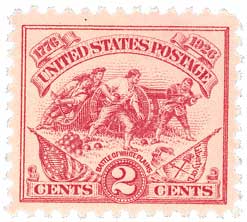
Battle of White Plains
The Battle of White Plains was a Revolutionary War battle fought on October 28, 1776. This stamp, issued on October 18, 1926, is entitled “Hamilton’s Battery” in honor of Alexander Hamilton, an outstanding artillery commander, and his men. Hamilton later served as the first secretary of the US Treasury. US #630 features the same design but was produced as a souvenir sheet (America’s first!) for the 1926 International Philatelic Exhibition.

Burgoyne Campaign
US #644 was issued on August 3, 1927. Although US #644 is called the “Burgoyne Campaign,” it commemorates several different events. In fact, General John Burgoyne isn’t the central character in the stamp and it wasn’t originally intended to honor him, as he was a British general fighting against America. The stamp pictures Burgoyne (left of center) handing his sword to General Horatio Gates of the Continental Army. The stamp image is based on John Trumbull’s 1821 painting Surrender of General Burgoyne.

Washington at Prayer

Battle of Monmouth
According to legend, Mary “Molly” Ludwig was the wife of an infantry sergeant. During the battle of Monmouth, she carried pitchers of water to the wounded soldiers, causing her to be nicknamed “Molly Pitcher.” When her husband was wounded during the conflict, Molly took his place at the canon and fought during the balance of the battle. As the anniversary of the Battle of Monmouth approached, New Jersey residents requested that a stamp be issued honoring the fabled heroine Molly Pitcher. However, the Post Office Department claimed it had issued its quota of commemoratives and couldn’t issue the stamp they wanted. After an extensive letter writing campaign, the Department agreed to issue an overprinted stamp, as they had done with the Discovery of Hawaii stamp. While New Jersey residents were happy to have their stamp, collectors and the general public were unimpressed with the stamp’s lack of creativity, not even showing who or what Molly Pitcher was. The stamp was issued on October 20, 1928.
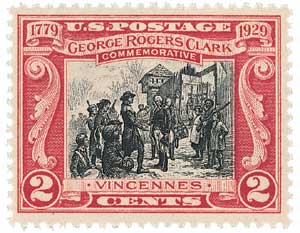
George Rogers Clark

Sullivan Expedition

Battle of Fallen Timbers
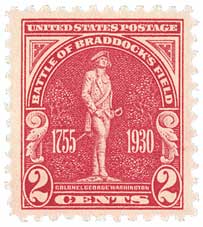
Battle of Broddock’s Field
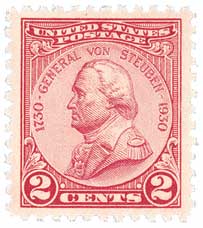
Von Steuben
Issued on September 17, 1930, US #689 commemorates the 200th anniversary of the birth of the Prussian-born General Baron Frederick Wilhelm von Steuben, whose exceptional services to the Colonial Army greatly improved their militarily techniques during the Revolutionary War.
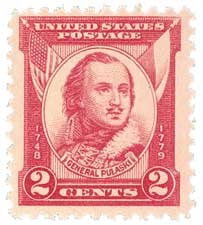
Pulaski
Benjamin Franklin recruited this Polish-born nobleman for the American cause when they met in Paris. Pulaski is considered the “father of the American cavalry.” He earned this title through his daring service as a brigadier general both in battle, and as the principal organizer of the American cavalry system. Referring to “Pulaski’s Legion,” a British officer said they were “the best damned cavalry the rebels ever had.” Pulaski served with great distinction under General Washington at the battle of Brandywine in September 1777. He was fatally wounded during the siege of Savannah in 1779. This stamp was issued on January 16, 1931.

Yorktown Issue
The Battle of Yorktown was the last major battle of the American Revolutionary War. At Yorktown, French and American forces worked together to crush the British army under General Charles Cornwallis. Issued on October 19, 1931, this stamp pictures General George Washington and his French allies, Lieutenant General Jean Rochambeau and Admiral François De Grasse.
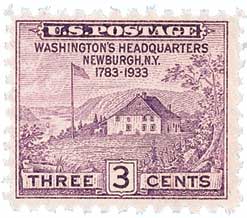
Washington’s Headquarters
In 1783, General George Washington issued a proclamation of peace from his headquarters at the Hasbrouck House in Newburgh, New York. This stamp commemorates the 150th anniversary of that proclamation which officially marked the end of hostilities of the Revolutionary War. This was the first stamp issued under President Franklin Roosevelt’s administration, on April 19, 1933. An avid collector, Roosevelt selected the design for the stamp himself!

General Thadeusz Kosciusko
Quite the extensive article. Nicely done.
Agree
Could use this article to show my 8th grade Social Studies class when they study
the Revolutionary War.
Wow, what a GREAT article
General Pulaski died in 1779, not 1797. He was 34 years old.
A GREAT history update … descriptive and informing detail. Another Mystic whopper ! Thanks, again !!